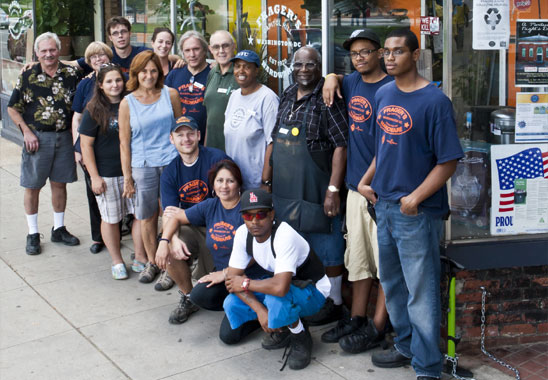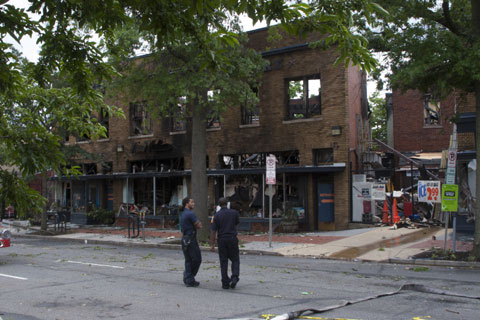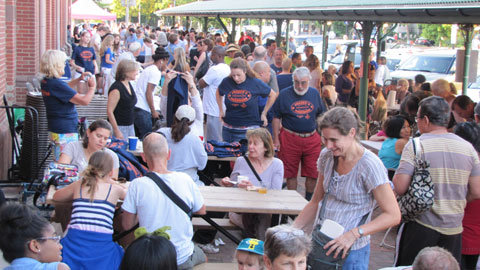Back in 1996, First Lady Hillary Clinton published It Takes a Village: And Other Lessons Children Teach Us, about the effects of extra-familial institutions and organizations on the nurturing of children. Conservatives didn’t like it. “It does not take a village to raise a child,” Bob Dole said. “It takes a family to raise a child.” Dole was right, since today the most important thing standing between a child flourishing and a child brain-scrambled by meth in the country or shot by gangsters in the city is a dad in the house. Hillary’s village—the dependency-inducing nanny state—hasn’t fared so well.

But that doesn’t mean that life in our reviving cities isn’t a village of a different kind. In my urban neighborhood, Capitol Hill in Washington D.C., a voluntary group called the Capitol Hill Village organizes services for the elderly. People young and old pay dues and volunteer to do chores for dues-paying residents who are avoiding the holding pen known as assisted living. Every year, the Village sponsors a fund-raising dance at the Atlas Theatre on the rapidly gentrifying H Street corridor that was the fiery epicenter of the 1968 D.C. riots. Another voluntary organization, the Capitol Hill Community Foundation, takes donations, especially from businesses, and distributes them as grants to neighborhood groups and projects. The foundation has provided more than $4 million in grants. Every dollar contributed gets used because the 30-member board of directors volunteers and pays out-of-pocket for all overhead and administrative costs. And this is not to mention the multitude of church groups tending to the needy and Internet groups that keep neighbors in touch, spread information and news, advertise yard sales, and organize block parties. All this developed without any legislation or support from the D.C. or federal governments.
Finally, a reason to check your email.
Sign up for our free newsletter today.

Capitol Hill is a village in another sense, too. People become acquainted in the course of everyday commercial life, mixed within residential blocks: we know the butchers and the fishmongers at Eastern Market, and they know us, so they tell us what’s fresh. We’ve always got a joke for them and they for us. Ditto for the artisans who sell at the market on weekends, such as the genius who makes giraffes and other animals from cut soda cans: his beautiful beasts rest in the corners of our house, and his big wire gecko, festooned with red and green beads, clings to the wall of our central staircase. The woodcarving guy from Surinam, who made our bedroom mirror, the table for our foyer, and a stool for me to tie my shoes, shakes my hand and gives my wife a hug and kiss and asks about our grandchildren. We talk about life and long-gone parents with my wife’s favorite jewelry artisan.
We know and chat often with the florist who turned a crummy corner building one block from our house into a fabulous indoor-outdoor flower shop, its centerpiece a multilevel, wrought-iron waterfall that gurgles in the summer and freezes into an ice sculpture in the winter. That helped inch up neighborhood property values. He keeps our townhouse rear deck verdant from spring to fall, so we are adding to his profits. In the basement of his store is a tiny market that sells artisanal specialty foods and reasonably priced wines and craft beer: we know the guys who run it, and they let us know when some especially good stuff comes in, so we are helping them pay their rent and turn a profit. When we were refinancing our house and I groused about the terms to the lady who cuts my hair, she dragged me to meet the local mortgage banker around the corner. He knew my house without looking it up, and we struck a deal that beat Wells Fargo by a mile and saved us loads of upfront cash. My wife now chats with the banker’s wife at our gym, not far away. We’ve since steered friends to that tiny bank, which has pulled off a lucrative real-estate deal.
Our neighborhood, in other words, is not a village in the anthropological sense of being rooted in folkways and time immemorial. Nor is it a village of social-justice do-gooding coerced by taxes and executed by anonymous bureaucrats. It no more springs from custom than it does from abstract moral intention. Rather, it’s closer to what Tocqueville saw in America: neighborliness and sociality, and thus morality, based on self-interest properly understood. I didn’t bond with the corner florist because of an imperative to love my neighbor; I did so first because he was improving the street and the property values. Absent those considerations, I can’t imagine why, much less how, I would have encountered him in the first place. The same goes for all the other connections I noted. People come together for mutual, material self-interest (a.k.a. profit); but they do so often and in close quarters, so they come to know and care for one another. This was illustrated in summer 2013, when a fire destroyed Frager’s, a hardware store and long-loved neighborhood institution.
About a year ago, my son-in-law and I converted a grill from propane to natural gas. It was a tougher job than expected, leading to several trips to Frager’s, which is about six blocks away from where I live. On Capitol Hill, everybody goes to Frager’s. After we spent half an hour digging through mounds of inventory, the salesperson found what he said that we needed. We took his word, though neither of us believed it. The Frager’s guy was right, though, and we finished just in time to fire up the grill for dinner.
Frager’s is a 90-year-old warren stuffed to the ceilings with anything one could ever need to keep house and home together. Its staff of 60 people are old and young, black and white, men and women, and all know the store like the back of their hands. If they can’t figure out what you need and how to use it, nobody can. It’s where you get locks and keys, paint, tools, flowers, hoses, brooms, fertilizer, bug spray, and parts for old electrical systems. You can rent a snow-cone machine for a child’s birthday party or buy a fan that looks like a chicken or a cat. You can get someone to spend a half-hour or more to find and then sell you one screw. Seven days a week, the narrow aisles are jammed with local residents and homeowners rich and poor, gardeners, contractors, property managers, professional plumbers and electricians, chimney sweeps, and old-timers who just like to hang out there.
In early June, we dined with friends who live near Frager’s. Just before dinner, as we were having some wine in their garden, the phone rang and our hostess let out a shriek: Frager’s was on fire, a four-alarm conflagration! We finished dinner, but nobody was in a good mood. The next morning, I called the contractor who works for us, who said that he would suffer financially: Frager’s stayed in business, he said, because it compensated for its slightly higher prices with its convenient location and remarkable staff expertise. His costs were now sure to spike and be passed on to his customers, he said, because a trip to the hardware store would now take at least twice the gas and time, and could wind up fruitless anyway, because what he needed just couldn’t be found at the Home Depot or a suburban hardware store. Ditto for the guy who maintains the spinning bikes in our gym. A few days later, he came to change some lightbulbs while I was sweating away: the bag he carried was from Frager’s. He told me that he went to Frager’s every day. Frager’s made money and helped its customers do the same: that’s not why it is beloved, but it could not have become beloved had it not been profitable for itself and others.
During and after the fire, people assembled to mourn Frager’s loss. Despite the 20,000 gallons of water per minute poured on the blaze, everything inside had been destroyed by the next morning, and the only things remaining were the brick front and side facades. Many wept and lamented that life in the neighborhood would never be the same. My wife had been planning a trip to Frager’s for the day after the fire and had to go through snarled traffic to a store much farther away. “How are we going to do without Frager’s?” she asked. Almost everyone on Capitol Hill was asking the same thing.
The store, a rambling brick building almost half a block long, was still smoldering the next morning when the village sprang into action. A hip bar and restaurant on H Street offered to take on some Frager’s employees, as did a local pretzel bakery and the group that owns an upscale Barracks Row pizza restaurant and bar. That same day, a Capitol Hill resident, the CEO of a local theater company, raised $30,250 before giving way to the Capitol Hill Community Foundation, which opened a special, tax-deductible fund: Friends of Frager’s collects donations on its website and at a booth on weekends at Eastern Market. The Hill Center, a voluntary nonprofit educational and community center, teamed up with DC Jazz to stage a concert in support of Frager’s. Food vendors and restaurateurs in the neighborhood sponsored Al Fresco for Frager’s, featuring the best neighborhood dishes. The fund-raising events kept springing up, and Friends of Frager’s has collected over $170,000. The Folger Shakespeare Theatre donated the proceeds of the last night of its brilliant Twelfth Night to Frager’s. It turns out that the theater needs Frager’s for every new production.
Nobody thinks that Frager’s can’t reopen without all this help—that’s what insurance is for. The issue for the community is not the store and its profits, but the people who work there. Neighbors want them to weather the financial storm while the business is rebuilt. I saw Frager’s chief cashier at least three or four times every month; at the counter, there was almost never time to talk, but she and her mates at the registers facilitated the smooth and courteous behavior of people in the long lines waiting to check out, and she looked you in the eye and smiled as best she could. The community wants to see her return to the job that she obviously loves and needs, and it will see to it that she does.

How am I so sure? Because something like this has happened before. On April 30, 2007, Eastern Market suffered the same fate as Frager’s. A fire gutted the landmark, built in 1873 and the only remaining public market in D.C. today. In addition to being the heart of the neighborhood, Eastern Market is also a major tourist attraction. On weekends, thousands of shoppers, tourists, and people out for a stroll mob the market and the vegetable and craft stall area around it; during the week, the market is a major source of food for the neighborhood. Political power brokers line up alongside yuppies and working-class people of all ethnicities and colors. You can pay a fortune for Serrano ham or artisanal chèvre or pick up a croaker or pigs’ ears or feet for a couple of bucks, or a smoked turkey neck or fresh rabbit, or some kimchi made by the Korean greengrocer. The fire was thus a disaster for D.C. as a whole, and since the city owns the place, it was imperative that it restore the building and provide a temporary location so that the market could resume functioning as soon as possible. The building restoration took two years. The village’s problem, which the city could not address, was the four-month interlude between the fire and the opening of the temporary structure. How were the employees to weather this financial storm? Some vendors weren’t well insured. Others tried to sell from makeshift stalls outside but ran into all kinds of problems with refrigeration and sanitation.
The village came to the rescue. The Capitol Hill Community Foundation set up a special fund for Eastern Market employees, just as it has now done for Frager’s. Individuals, businesses (including local restaurants), the Capitol Hill Association of Merchants and Professionals, and other organizations all donated generously. In the end, the foundation managed over $500,000 in community contributions to help Eastern Market employees. The result: not one of the employees, many of them first-generation immigrants, lost a job. When the temporary market opened, only the location had changed.
Four days after the Frager’s fire, the business opened a “pop-up” garden store on the concrete slab still remaining of the temporary Eastern Market structure (the market building reopened in 2009). Community bloggers urged residents to buy every plant in stock, and the checkout line that first day stretched for a block. By closing time, Friends of Frager’s had raised $15,000. The chief cashier remains on the job as the pop-up site expands its range of services and products. Frager’s will have a tougher time than did the Eastern Market, though. According to its owner, a kind man named John Weintraub, rebuilding and getting back to business on the hallowed spot will take at least two difficult years.
Weintraub isn’t a young man, having purchased Frager’s with a fraternity buddy in the mid-1970s. He has run a hardware store, he said, not a property-development company, which he’s now forced to do. His home serves as temporary office space. He has had to negotiate with the insurance company (so far, so good) and contend with the byzantine world of the D.C. building and zoning departments. The city has offered help: it loaned the temporary Eastern Market slab and has indicated its willingness to be reasonable about property taxes on the store lot. But you can’t negotiate the D.C. building-bureaucracy maze without expensive permits and the services of costly “expediters.” Even securing temporary retail space can’t be done quickly, given the regulatory hurdles: despite official goodwill, it took three months to open a temporary paint store in a vacant restaurant down the block. Ditto for a makeshift location for rentals and hardware. I could see the strain on Weintraub’s face. By far, the most painful thing he had to do was lay off 25 members of the peak-season staff of 60 full- and part-time employees. The awful task was made easier, he said, by the outpouring of cash from the Capitol Hill Village to support the laid-off employees and ease them into new jobs with community businesses, or to help them get the unemployment insurance for which they’re eligible. Donations continue to flow into Friends of Frager’s.
When Weintraub loses heart, his spirits get a boost from the people walking around with Frager’s T-shirts bearing the slogan, “Not On Our Watch.” That was the store’s general manager’s comment when asked if Frager’s would disappear. It’s the sentiment, too, of the Capitol Hill Village.
This kind of support is not likely to have surfaced if Frager’s and Eastern Market had put their faith in Hillary Clinton’s version of community. Consider a Wall Street Journal article last summer about the AmeriCorps program, in which James Bovard described the complete absence of results-based evaluation. In 2000, the Government Accountability Office complained that evaluations “do not measure AmeriCorps programs’ progress toward the strategic goals of strengthening communities and improving participants’ lives, as required by the Government Performance and Results Act of 1993.” Another GAO report in 2004 reported that AmeriCorps didn’t seem to know how many participants it had on its rolls. Until recently, AmeriCorps had no permanent inspector general at its oversight agency, since, in 2009, it fired its IG for standing by a report that hundreds of thousands of AmeriCorps dollars had been misused and for issuing a report that one large AmeriCorps program had “failed to report any positive results.” That village hasn’t worked, and it costs taxpayers some $446 million per year. Thankfully, neither the employees at Eastern Market nor at Frager’s depended on AmeriCorps. It takes a village, yes; but only a real one will do.
